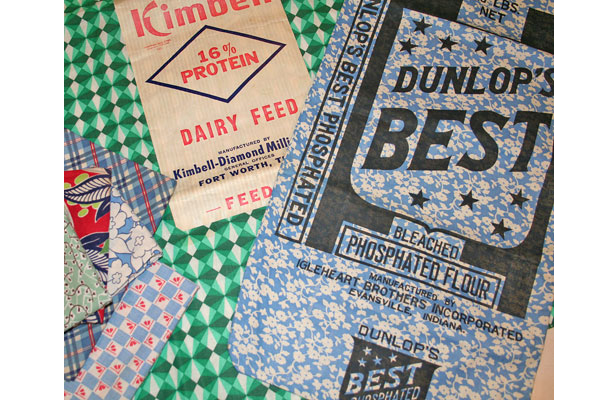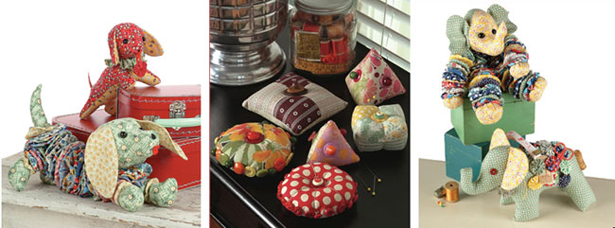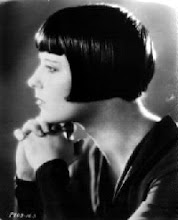Found this fabulous article on line. Enjoy!
Sew Vintage: Feedsack
 I thoroughly enjoyed writing last week’s history piece on mother-of-pearl buttons. So much so that I thought I would write another vintage/history post this week on the always glamorous topic of …wait for it…feedsacks.
I thoroughly enjoyed writing last week’s history piece on mother-of-pearl buttons. So much so that I thought I would write another vintage/history post this week on the always glamorous topic of …wait for it…feedsacks.
In the early 1800s, due to an advancement in the quality of the materials and their construction, the manufacturers of staples such as grain, flour, sugar and animal feed transitioned from shipping in boxes and tins to, instead, cotton canvas bags. With the introduction of this new cloth into the home, thrifty women everywhere began to reuse the cloth for a variety of home uses – dish towels, diapers, and more. The bags began to become popular for clothing items as well. Realizing this recycling trend was here to stay, the manufacturers began to print their cloth bags – or feedsacks – in a variety of patterns and colors, assuming that they could sell more feed and seed if their feedsacks were desired by more women than their competitor’s.
Over time, the popularity of the feedsack as clothing fabric increased beyond anyone’s wildest expectations, fueled by both ingenuity and scarcity. By the time WWII dominated the lives of Americans, and cloth for fabric was in short supply due to its use in the construction of uniforms, it was estimated that over three and a half million women and children were wearing garments created from feedsacks.

As you can imagine, with this volume of use, the manufacturers began to compete with each other to provide the most useful and attractive feedsacks. Some printed sewing patterns right on the feedsacks while others printed beautiful, and sometimes elaborate themes and patterns. There were even entire books published showing fashionable designs, which sacks to use for what purpose and even pattern layouts (see the “Bag of Tricks” example). For collectors today, many of these feedsack-related items are extremely desired.
Naturally, as technology facilitated the adoption of feedsacks initially, it also hurried its eventual demise. After WWII, the advancement of paper manufacturing, and eventually the development of plastics, made it significantly cheaper to package staples in alternative packages and the use of feedsacks ended.

As many of you know, I am an avid – sometimes obsessive – collector of a variety of vintage items. Over the years, a number of wonderful feedsack samples have ended up in my collection. Subsequently, these feedsack designs ended up influencing a number of items at indygo Junction, including our Pieced Pincushions and a number of our Yo Yo patterns (see them here and here). A vintage Mother Goose feedsack inspired, not only our embroidery book, A Stitch In Time with Mother Goose, but also a line of fabrics I did for Red Rooster.

Recently, when I was designing my latest book, Vintage Notions, the designers and I came up with the idea of scanning my collection for use as decorative borders throughout the book (see the samples above). As well, if you look at the cover of the book, you’ll see that it’s composed from samples of feedsacks from my collection as well (see above). This worked out so beautifully and added, not just a colorful touch, but a historical link to an important part of this country’s history and development of fabrics for fashion.
What about you? Have you ever made anything out of feedsacks (they’re still obtainable on eBay)? If you’ve ever looked through that trunk of pictures in your attic, have you ever found pictures of your mother of grandmother wearing dresses made from flowery feedsack patterns of the time?
Thank you all again for letting me share my love of all things vintage.
~ Amy
Amy Barickman is the founder and owner of Indygo Junction, The Vintage Workshop and AmyBarckman.com. She is a leader in the sewing, needle arts and retail crafting industry having sold more than two-million sewing patterns and published 80 books sold throughout the world. Her recent endeavor is the book “Amy Barickman’s Vintage Notions: An Inspirational Guide to Needlework, Cooking, Sewing, Fashion and Fun”, is already on its third printing since its release in September of 2010. Other best-selling titles include: “Indygo Junction’s Button Ware” and, most recently, “Hankie Style”.

No comments:
Post a Comment